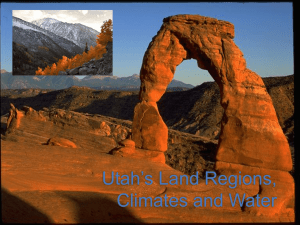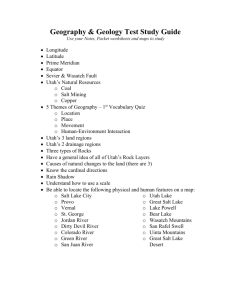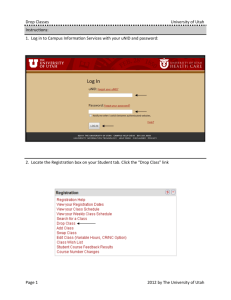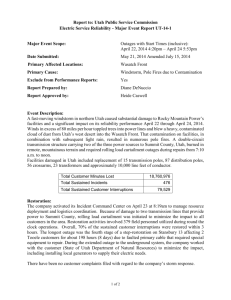First Grade - Kimball Art Center
advertisement
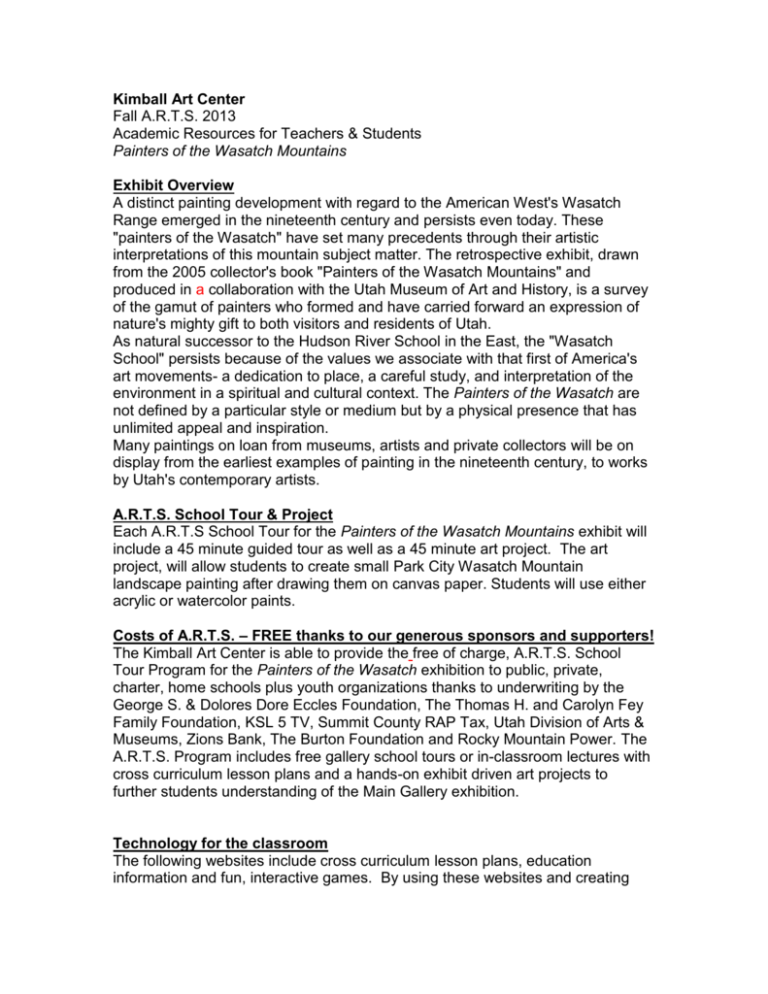
Kimball Art Center Fall A.R.T.S. 2013 Academic Resources for Teachers & Students Painters of the Wasatch Mountains Exhibit Overview A distinct painting development with regard to the American West's Wasatch Range emerged in the nineteenth century and persists even today. These "painters of the Wasatch" have set many precedents through their artistic interpretations of this mountain subject matter. The retrospective exhibit, drawn from the 2005 collector's book "Painters of the Wasatch Mountains" and produced in a collaboration with the Utah Museum of Art and History, is a survey of the gamut of painters who formed and have carried forward an expression of nature's mighty gift to both visitors and residents of Utah. As natural successor to the Hudson River School in the East, the "Wasatch School" persists because of the values we associate with that first of America's art movements- a dedication to place, a careful study, and interpretation of the environment in a spiritual and cultural context. The Painters of the Wasatch are not defined by a particular style or medium but by a physical presence that has unlimited appeal and inspiration. Many paintings on loan from museums, artists and private collectors will be on display from the earliest examples of painting in the nineteenth century, to works by Utah's contemporary artists. A.R.T.S. School Tour & Project Each A.R.T.S School Tour for the Painters of the Wasatch Mountains exhibit will include a 45 minute guided tour as well as a 45 minute art project. The art project, will allow students to create small Park City Wasatch Mountain landscape painting after drawing them on canvas paper. Students will use either acrylic or watercolor paints. Costs of A.R.T.S. – FREE thanks to our generous sponsors and supporters! The Kimball Art Center is able to provide the free of charge, A.R.T.S. School Tour Program for the Painters of the Wasatch exhibition to public, private, charter, home schools plus youth organizations thanks to underwriting by the George S. & Dolores Dore Eccles Foundation, The Thomas H. and Carolyn Fey Family Foundation, KSL 5 TV, Summit County RAP Tax, Utah Division of Arts & Museums, Zions Bank, The Burton Foundation and Rocky Mountain Power. The A.R.T.S. Program includes free gallery school tours or in-classroom lectures with cross curriculum lesson plans and a hands-on exhibit driven art projects to further students understanding of the Main Gallery exhibition. Technology for the classroom The following websites include cross curriculum lesson plans, education information and fun, interactive games. By using these websites and creating pre and post visit activities in your classroom, children will be more involved and retain more knowledge about these subjects. Please visit these following website links. 1.Learn about artist Maynard Dixon. http://www.maynarddixonpaintings.com/ 2. Learn about artist Susan Swartz and see her art work. http://play.lego.com/en-us/default.aspx 3. Information about Utah’s Mountains http://historytogo.utah.gov/utah_chapters/the_land/physicalgeographyofutah.html 4. Learn about fun Utah facts! http://www.ducksters.com/geography/state.php?State=Utah 5. Take the Utah State Map Quiz and color it in! http://www.enchantedlearning.com/usa/statesbw/utah.shtml 6. Learn about Utah State History, see old writings and contracts, and learn about various tribes and people who settled the lands and lived here before you and made Utah what it is today. http://www.ilovehistory.utah.gov/index.html 7. Mountain Ranges in Utah http://en.wikipedia.org/wiki/List_of_mountain_ranges_of_Utah Background Information Painters of the Wasatch Mountains During the 19th century, a painting movement established itself in the western region of the United States. The Painters of the Wasatch, are a distinct group of artists who create a sequence of work based on the regional context of the Wasatch Mountains. This group formed in the same century in which both the Rocky Mountain School and the infamous Hudson River School in New York established themselves, focusing on the subject of regional, mountainous landscape. The Wasatch Range divides Utah into roughly two equal parts. The range attracts a large number of storms, capturing more rain and snow than anywhere else in the state. As a result, 80 percent of Utah’s population resides on the western side of the Wasatch Mountains, also known as the Wasatch Front. Considered a part of the Rocky Mountains, the Wasatch Range provides the Painters of the Wasatch with a different geological landscape that lacks the long foothills typical of the Rockies. When Mormon settlers came through the canyons of the Wasatch Front, the area became an iconic aspect of Utah’s landscape, and came to be known as the Kingdom of Deseret. Much like the scenic inspiration at the start of the Hudson River School, the landscape of the Wasatch Range became an important setting of study and careful scrutiny by local and newly established immigrant artists. The Painters of the Wasatch refrain from creating a stylistically similar expression of the region in the way the Rocky Mountain School did. These artists are not defined by a particular style or medium, but by a physical presence that has unlimited appeal and inspiration. The Painters of the Wasatch continue to flourish and provide artists with the values that are associated with the influence of America’s first landscapes in art. This retrospective exhibit, presented by the Kimball Art Center in association with the Museum of Utah Art and History, is based on the collectors’ book Painters of the Wasatch Mountains. Most of the pieces in the show appear in the book, and are on loan from both museums and private collections, as well as from one notable contemporary artist. A wide variety of styles, depicting the same subject matter over more than a century, show how the Painters of the Wasatch have both evolved yet stayed true to their inspiration in the local landscape. Many thanks for the invaluable help of Richard Horne, Kandace Steadman, Ann Orton and James Wooley in assisting to bring the exhibit together, as well as to The Utah Division of Arts and Museums Fine Arts Collection, The Springville Museum of Art, Ray Quinney and Nebeker P.C., Jonathan A. Dibble, Phoebe Hailey, Diane and Sam Stewart, and Susan Swartz for the loan of their art. Keywords, People, Places, & Vocabulary for Visitors to know: Wasatch Mountains Mountain Range Rocky Mountains Utah Deseret Lesson Plan First Grade Core Curriculum Ties Standard 3 (Geography): Students will use geographic tools to demonstrate how symbols and models are used to represent features of the school, the neighborhood, and the real world. Objective 1 Identify and use geographic terms and tools. a. Use a compass to locate cardinal directions. b. Identify the equator and north and south poles. c. Identify Utah on a variety of maps and on a globe. d. Identify the United States on a variety of maps and on a globe. Objective 2 Recognize and use a map or a globe. a. Create a map showing important sites or landmarks on a school or community (i.e., firehouse, city hall, churches). b. Locate physical features (i.e. continents, oceans, rivers, lakes), and manmade features (equator, North and South poles, countries) on a map and on a globe. c. Identify the compass rose and cardinal directions on a map and on a globe. Materials Images of Painters of the Wasatch Mountains Exhibition Images included in the ARTS website. Pencils White or Black board with appropriate writing utensils Paper for students to draw a map. Crayons, markers or other coloring media. Map of the state of Utah, Western United States or North America. Compass for the classroom. Blank Utah Map Print Out – Or Cut a corner off of a piece of white paper and have the kids make the map the shape of Utah. Intended Learning Outcomes: Students will be able use appropriate skills for working in a group. Students will be able to use a compass, cardinal directions and establish North, South, East, West in the classroom. Students will be able to identify Utah on various maps. Students will be able to locate features on a map or globe. Students will be able to identify important landmarks in their community. Instructional Procedures 1.Teachers show students pictures of Painters of the Wasatch Mountains work and explain to students these images are all by different artists. Ask the students to identify what is the same in all of them (answer: there are mountains, and these mountains are the Wasatch Mountains of the State of Utah! Utah was the 45th state and is in the country United States of America. 2. In the images point out other physical features such as hills, lakes, rivers, homes and roads. As students to say if a house is near or far from the mountains, is the river near or far from the house etc… explain to students that directions are used to help tell people where things are in relation to each object. 3. Using a map, show students where they live, rivers or lakes near them, and special National Parks or State Forests, deserts, and other landmarks of your state. 4. Ask students if the Great Salt Lake is near their house, or far from it? Do they have roads near their house or school? What is far away from where you live? What types of physical features are where you live? Do this as a whole class so students can listen and watch you point on the map. 5. Show students the compass on the map and introduce cardinal directions. Show students a real compass tool, and establish where North, South, East and West are in your classroom. Post these directions up for your class to see. 6. Show students a large map of the United States of America. Show them the compass on the map. Ask students questions about where Utah is located in comparison to other states or national landmarks. (ie. Utah is what direction from Arizona?, Utah is what direction from New York, the closest coastal beach is in what direction from Utah?) 7. Show students a large map of Utah. Talk about the shape of the state, it looks like a rectangle, but a part was take out of the top. Discuss where you live, what is around your city; what cities are close to you and far away. Using cardinal directions and the map’s compass, discuss what is close and far, north, south, east and west, include landmarks, physical features etc. 8. Give students a piece of white paper or blank state shape print out. Explain to students that they are going to make their own map. The map should include the following: A. Compass B. City where they live and a symbol to represent it c. State Capitol, if in Utah, Salt Lake City d. Great Salt Lake, if in Utah, if not, then a significant body of water or river near where you live. e. State landmark or physical feature of their choice – if in Utah, this could be a national forest, another city or town of significance, mountain range etc. *make sure to keep a full state map up of the state you live in, so students can see all the different things to choose from. Show them how they can make a squiggly blue line for a river, a blue organic shape or blob for a lake, triangle tops for a mountain range and so on. Each student can pick out the individual things they think makes their state unique. 9. Allow students time to create and color their map and make it their own. 9. As students are finishing at different times, on another piece of paper have students write where things are in relation to their city. (ie. The city __ that I live in is (direction) of Salt Lake City (capitol city). The river or lake I live near is (direction). Etc…) 10. Post all maps up on a bulletin board or in the classroom with the papers they wrote next to them for all to see. Check student’s work and correct directions if needed. Assessment Students use appropriate skills for working in a group. Students use a compass, cardinal directions, and establish North, South, East, West in the classroom. Students identify Utah on various maps. Students locate features on a map or globe. Students identify important landmarks in their community.
